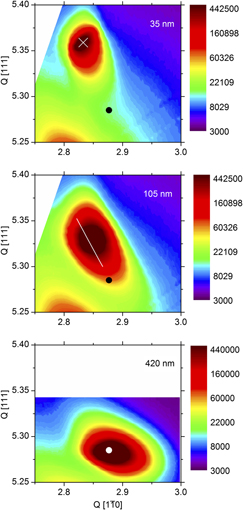Article contents
A study of (111) oriented epitaxial thin films of In2O3 on cubic Y-doped ZrO2 by synchrotron-based x-ray diffraction
Published online by Cambridge University Press: 15 June 2012
Abstract

Reciprocal space mapping using synchrotron-based x-ray diffraction has been used to study the effects of strain and strain relaxation in (111) oriented thin films of In2O3 on cubic Y-stabilized ZrO2 over a range of epilayer thicknesses between 35 and 420 nm. Maps around the epilayer (1026) reflection show that the 35-nm film is highly strained with a lateral periodicity close to that of the substrate, while the 420-nm film is almost completely relaxed. Analysis of the map for the former sample leads to an estimate of 0.31 for the Poisson ratio for In2O3. The mosaic spread deduced from transverse scans through the epilayer (444) and (666) reflections increases from 0.1° for the 35-nm-thick film to 0.3° for the 420-nm-thick film. These changes are discussed in relation to the morphological changes observed by atomic force microscopy.
- Type
- Articles
- Information
- Journal of Materials Research , Volume 27 , Issue 17: Focus Issue: Oxide Semiconductors , 14 September 2012 , pp. 2257 - 2264
- Copyright
- Copyright © Materials Research Society 2012
References
REFERENCES
- 7
- Cited by


